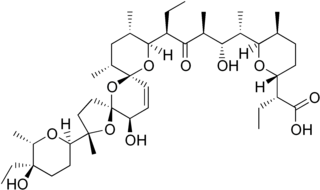
Nonactin is a member of a family of naturally occurring cyclic ionophores known as the macrotetrolide antibiotics. The other members of this homologous family are monactin, dinactin, trinactin and tetranactin which are all neutral ionophoric substances and higher homologs of nonactin. Collectively, this class is known as the nactins. Nonactin is soluble in methanol, dichloromethane, ethyl acetate and DMSO, but insoluble in water.

Streptomyces is the largest genus of Actinomycetota and the type genus of the family Streptomycetaceae. Over 500 species of Streptomyces bacteria have been described. As with the other Actinomycetota, streptomycetes are gram-positive, and have genomes with high GC content. Found predominantly in soil and decaying vegetation, most streptomycetes produce spores, and are noted for their distinct "earthy" odor that results from production of a volatile metabolite, geosmin.
Polyketides are a class of natural products derived from a precursor molecule consisting of a chain of alternating ketone (or reduced forms of a ketone) and methylene groups: (-CO-CH2-). First studied in the early 20th century, discovery, biosynthesis, and application of polyketides has evolved. It is a large and diverse group of secondary metabolites caused by its complex biosynthesis which resembles that of fatty acid synthesis. Because of this diversity, polyketides can have various medicinal, agricultural, and industrial applications. Many polyketides are medicinal or exhibit acute toxicity. Biotechnology has enabled discovery of more naturally-occurring polyketides and evolution of new polyketides with novel or improved bioactivity.

A23187 is a mobile ion-carrier that forms stable complexes with divalent cations. A23187 is also known as Calcimycin, Calcium Ionophore, Antibiotic A23187 and Calcium Ionophore A23187. It is produced at fermentation of Streptomyceschartreusensis.

Salinomycin is an antibacterial and coccidiostat ionophore therapeutic drug.
Streptomyces chartreusis is a bacterium species from the genus of Streptomyces which has been isolated from soil in Africa. Streptomyces chartreusis produces N-deacyltunicamycin, elsamicin A, aminoacylase and chartreusin.
Streptomyces chryseus is a bacterium species from the genus of Streptomyces.
Streptomyces galbus is a bacterium species from the genus of Streptomyces which has been isolated from soil from West Bengal. Streptomyces galbus produces xylanase, galbonolides A, galbonolides B and the actinomycin X complex.
Streptomyces griseoluteus is a bacterium species from the genus of Streptomyces which has been isolated from soil in Tokyo in Japan. Streptomyces griseoluteus produces griseoluteic acid, griseolutein A and griseolutein B.
Streptomyces lomondensis is a bacterium species from the genus of Streptomyces which has been isolated from soil. Streptomyces lomondensis produces the antibiotic lomofungin.
Streptomyces luteogriseus is a bacterium species from the genus of Streptomyces. Streptomyces luteogriseus produces peliomycin and (+)-(S)-streptonol A.
Streptomyces lydicus is a bacterium species from the genus of Streptomyces which has been isolated from soil in the United States. Streptomyces lydicus produces actithiazic acid, natamycin, lydimycin, streptolydigin, and 1-deoxygalactonojirimycin. Streptomyces lydicus can be used as an agent against fungal plant pathogens like Fusarium, Pythium, Phytophthora, Rhizoctonia and Verticillum.
Streptomyces melanosporofaciens is a bacterium species from the genus of Streptomyces which has been isolated from soil in Italy. Streptomyces melanosporofaciens produces elaiophylin, cyclooctatin, geldanamycin, chilaphylin and melanosporin. A mutant of Streptomyces melanosporofaciens has the ability to protect potatoes from common scab.
Streptomyces microflavus is a bacterium species from the genus of Streptomyces which has been isolated from soil. Streptomyces microflavus produces nemadectin, fattiviracin A1, milbemycin and deoxyuridines. Streptomyces microflavus also produces the ionophore valinomycin. Streptomyces microflavus is also known to cause potato common scab disease in Korea.
Streptomyces parvulus is a bacterium species from the genus of Streptomyces which has been isolated from soil. Streptomyces parvulus produces the peptide antibiotic Actinomycin D and the angiogenesis inhibitor borrelidin and manumycin A, himalomycin A, himalomycin B and kynurenine.
Streptomyces platensis is a bacterium species from the genus of Streptomyces which has been isolated from soil. Streptomyces platensis produces oxytetracycline, platensimycin, migrastatin, isomigrastatin, platencin, dorrigocin A, dorrigocin B and terramycine.
Streptomyces prunicolor is a bacterium species from the genus of Streptomyces which has been isolated from soil in Russia. Streptomyces prunicolor produces Pironetin and the free radical scavengers benthocyanin A, benthocyanin B and benthocyanin C.
Streptomyces rochei is a bacterium species from the genus of Streptomyces which has been isolated from soil in Russia. Streptomyces rochei produces borrelidin, butyrolactol A, butyrolactol B, uricase and streptothricin. Streptomyces rochei has antifungal activity against Fusarium oxysporum f.sp. lycopersici and Aspergillus fumigatus. Streptomyces rochei produces moenomycin and bambermycin. Streptomyces rochei produces amicetin A, amicetin B, amicetin C and streptolin. Streptomyces rochei produces endo-β-N-acetylglucosaminidase mithramycin, amicetin, bamicetin, and plicacetin.
Streptomyces virginiae is a bacterium species from the genus of Streptomyces which has been isolated from soil. Streptomyces virginiae produces actithiazic acid, virginiamycins and cycloserine. Streptomyces virginiae also produces monensin A, monensin B, monensin C, monensin D, actithiazic acid.

Borrelidin is an 18-membered polyketide macrolide derived from several Streptomyces species. First discovered in 1949 from Streptomyces rochei, Borrelidin shows antibacterial activity by acting as an inhibitor of threonyl-tRNA synthetase and features a nitrile moiety, a unique functionality in natural products., Borrelidin also exhibits potent angiogenesis inhibition, which was shown in a rat aorta matrix model. Other studies have been performed to show that low concentrations of borrelidin can suppress growth and induce apoptosis in malignant acute lymphoblastic leukemia cells. Borredlidin's antimalarial activity has also been shown in vitro and in vivo.




